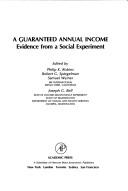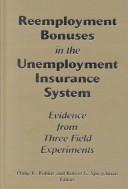| Listing 1 - 10 of 10 |
Sort by
|

ISBN: 9780125898805 0125898800 Year: 1980 Publisher: New York: Academic press,
Abstract | Keywords | Export | Availability | Bookmark
 Loading...
Loading...Choose an application
- Reference Manager
- EndNote
- RefWorks (Direct export to RefWorks)
Digital
Year: 1996 Publisher: Cambridge, Mass. National Bureau of Economic Research
Abstract | Keywords | Export | Availability | Bookmark
 Loading...
Loading...Choose an application
- Reference Manager
- EndNote
- RefWorks (Direct export to RefWorks)

ISBN: 0880992255 9780880992251 Year: 2001 Publisher: Kalamazoo: Upjohn institute,
Abstract | Keywords | Export | Availability | Bookmark
 Loading...
Loading...Choose an application
- Reference Manager
- EndNote
- RefWorks (Direct export to RefWorks)
Unemployment insurance --- Welfare recipients --- Bonuses (Employee fringe benefits)
Digital
Year: 2001 Publisher: Cambridge, Mass. National Bureau of Economic Research
Abstract | Keywords | Export | Availability | Bookmark
 Loading...
Loading...Choose an application
- Reference Manager
- EndNote
- RefWorks (Direct export to RefWorks)
Book
Year: 2001 Publisher: Cambridge National Bureau Of Economic Research. Working Paper Nr. 8444
Abstract | Keywords | Export | Availability | Bookmark
 Loading...
Loading...Choose an application
- Reference Manager
- EndNote
- RefWorks (Direct export to RefWorks)
Digital
Year: 1999 Publisher: Cambridge, Mass. National Bureau of Economic Research
Abstract | Keywords | Export | Availability | Bookmark
 Loading...
Loading...Choose an application
- Reference Manager
- EndNote
- RefWorks (Direct export to RefWorks)
Book
Year: 1996 Publisher: Cambridge, Mass. National Bureau of Economic Research
Abstract | Keywords | Export | Availability | Bookmark
 Loading...
Loading...Choose an application
- Reference Manager
- EndNote
- RefWorks (Direct export to RefWorks)
This paper reports on a randomized evaluation of an earnings subsidy offered to long-term welfare recipients in Canada. The program -- known as the Self-Sufficiency Project (SSP) -- provides a supplement equal to one-half of the difference between a target earnings level and a participant's actual earnings. The SSP supplement is similar to a negative income tax with two important differences: (1) eligibility is limited to long-term welfare recipients who find a full-time job; and (2) the payment depends on individual earnings rather than family income. Our evaluation is based on a classical randomized design: one half of a group of single parents who had been on welfare for over a year were eligible to receive the SSP supplement, while the other half were assigned to a control group. Results for an early cohort of SSP participants and controls suggest that the financial incentives of the Self-Sufficiency Program increase labor market attachment and reduce welfare participation.
Book
Year: 1998 Publisher: Cambridge, Mass. National Bureau of Economic Research
Abstract | Keywords | Export | Availability | Bookmark
 Loading...
Loading...Choose an application
- Reference Manager
- EndNote
- RefWorks (Direct export to RefWorks)
The Self-Sufficiency Project (SSP) is a large scale social experiment being conducted in Canada to evaluate the effects of an earnings supplement (or subsidy) for long-term welfare recipients who find a full-time job and leave income assistance. The supplement is available to single parents who have received income assistance for a year or more, and typically doubles the gross take-home pay of recipients. A critical issue in the evaluation of SSP is whether the availability of the supplement would lead some new income assistance recipients to prolong their stay on welfare in order to gain eligibility. A separate experiment was conducted to measure the magnitude of this effect. One half of a group of new applicants was informed that they would be eligible to receive SSP if they stayed on income assistance for a year; the other half was randomly assigned to a control group. Our analysis indicates a very modest exit
Book
Year: 1999 Publisher: Cambridge, Mass. National Bureau of Economic Research
Abstract | Keywords | Export | Availability | Bookmark
 Loading...
Loading...Choose an application
- Reference Manager
- EndNote
- RefWorks (Direct export to RefWorks)
This paper investigates the impact of financial incentive programs, which have become an increasingly common component of welfare programs. We review experimental evidence from several such programs. Financial incentive programs appear to increase work and raise income (lower poverty), but cost somewhat more than alternative welfare programs. In particular, windfall beneficiaries -- those who would have been working anyway -- can raise costs by participating in the program. Several existing programs limit this effect by targeting long-term welfare recipients or by limiting benefits to full-time workers. At the same time, because financial incentive programs transfer support to working low-income families, the increase in costs due to windfall beneficiaries makes these programs more effective at alleviating poverty and raising incomes. Evidence also indicates that combining financial incentive programs with job search and job support services can increase both employment and income gains. Non-experimental evidence from the Earned Income Tax Credit (EITC) and from state Temporary Assistance to Needy Families (TANF) programs with enhanced earnings disregards also suggests that these programs increase employment, and this evidence is consistent with the experimental evidence on the impact of financial incentive programs.
Book
Year: 2001 Publisher: Cambridge, Mass. National Bureau of Economic Research
Abstract | Keywords | Export | Availability | Bookmark
 Loading...
Loading...Choose an application
- Reference Manager
- EndNote
- RefWorks (Direct export to RefWorks)
We study the rate of wage growth among welfare leavers in the Self Sufficiency Program (SSP), an experimental earnings subsidy offered to long-term welfare recipients in Canada. Single parents who started working in response to the SSP incentive are younger, less educated, and have more young children than those who would have been working regardless of the program. They also earn relatively low wages in their first few months of work: typically within $1 of the minimum wage. Despite these differences, their rate of wage growth is similar to other welfare leavers. We estimate that people who were induced to work by SSP experienced real wage growth of about 2.5 - 3 percent per year - a rate consistent with conventional measures of the return to experience for similar workers.
| Listing 1 - 10 of 10 |
Sort by
|

 Search
Search Feedback
Feedback About UniCat
About UniCat  Help
Help News
News